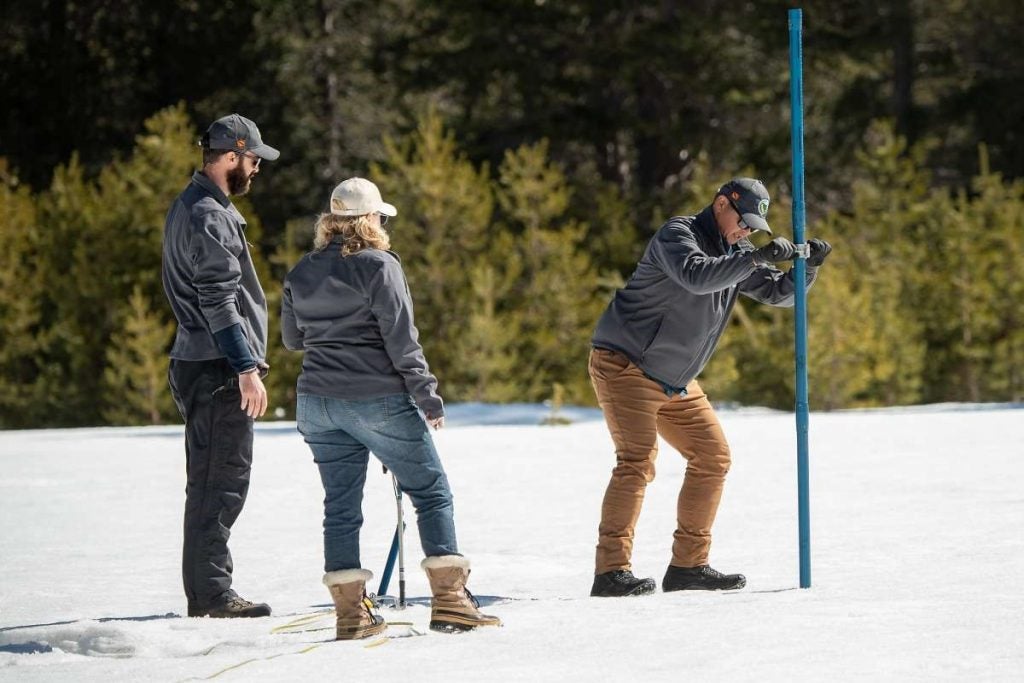Despite the much-needed April showers we saw this week, our normally wet January and February were bone dry in most of California. So it came as little surprise when the annual April 1 snowpack measurement in the Sierras came in low, at about 53% of average statewide. It’s another important reminder of how California’s weather, and consequently our water supplies, are swinging to greater extremes.
The low snowpack and extreme weather makes it more imperative than ever to carefully manage another part of our water system: underground water supplies.
We need to measure groundwater as actively as we measure snowpack and double down on efforts to successfully implement the Sustainable Groundwater Management Act (SGMA). Here are three ways to help ensure more sustainable groundwater supplies for generations to come.
1. Manage and maintain groundwater basins like dams and reservoirs
Historically, we didn’t pay much attention to groundwater until something went wrong, like wells going dry, people running out of drinking water or land sinking — all of which happened during California’s last drought. As a result, groundwater management has been underfunded and undermonitored, and this enormously valuable resource has gone underutilized.
Instead, we should think of groundwater basins from an engineering standpoint as valuable infrastructure — natural infrastructure. Groundwater is a truly magical resource that we can manage more strategically to create a more resilient future for California and other parts of the world.
Like our dams, canals and water pipes, groundwater basins already collect, store and deliver water to groundwater users, who tap into this storage and delivery system through wells. Like other man-made water infrastructure, we need to closely monitor and maintain our groundwater basins. And with proactive strategies like managed recharge, these groundwater basins can provide the added benefit of serving as multiyear buffers against more extreme weather.

Sean de Guzman (right) of the California Department of Water Resources highlighted the increasing frequency of extreme weather in this statement on the state’s April 1 snowpack measurement: “In the past 10 years, we’ve seen three of our smallest snowpacks on record, but we’ve also seen three of our largest snowpacks on record.”
Photo: Ken James / California Department of Water Resources
2. Don’t blame SGMA
SGMA offers us a framework to better take advantage of the valuable benefits provided by groundwater basins, but some have painted it as the culprit of future job and revenue losses in the San Joaquin Valley.
I empathize with valley communities, farmers and farm workers worried about how bringing groundwater basins into balance will affect their future and the region’s economy. But SGMA is not the problem. Rather, we are in this situation because of our decades-long reliance on unsustainable groundwater pumping to meet our water needs.
Without SGMA, overpumping would certainly have continued much longer, creating a condition where the deepest well wins, and communities, small farmers and ecosystems lose.
However, you can’t continue to overdraw an account indefinitely. Eventually, groundwater pumping would have to be curbed, and farmland losses and economic impacts would be even more severe than under SGMA. Without SGMA, the impacts would be uncontrolled and the costs would fall even more heavily on those least able to bear them.
SGMA enables local managers to steer the transition to a balanced groundwater system in a deliberate way that avoids a destructive race to the bottom. And, if done smartly, we can even bring state guidance and funding to bear and steer toward a better future by unlocking more benefits of proactive groundwater management. Three ways groundwater managers, farmers and policymakers can ensure more sustainable water supplies for California. Share on X
3. Help farmers and communities plan creatively and build resilience
Under SGMA, we can use strategies such as better water accounting, water transactions, infrastructure improvements, integrated management of groundwater and surface water, and managed aquifer recharge to reduce economic losses and build a better, more resilient future for the San Joaquin Valley.
With sustainability agencies in place, communities can use the authorities and flexibility in SGMA to encourage farming adjustments, plan proactively, think creatively and collaborate on solutions to develop a new vision for their economic wellbeing.
The Newsom administration has signaled that the state is ready to dig in, with guidance and resources to help. So the time is now to roll up our sleeves and get to work, because this won’t be easy and new ideas and successful collaborations take time to be perfected.
I’m heartened that some communities are starting to more proactively plan for the future. For instance, the Kaweah Subbasin in the southern San Joaquin Valley is starting a process to determine how to strategically and voluntarily repurpose agricultural lands to habitat, recreational spaces, solar farms and other possibilities developed by the region’s diverse stakeholders to provide a range of benefits to their communities.
I’m optimistic more communities will follow a similar path.
We have to get groundwater management right, and through thoughtful SGMA implementation, unlock the amazing potential of the natural infrastructure of our groundwater basins — the communities, farms, economies and ecosystems of California depend on it.









